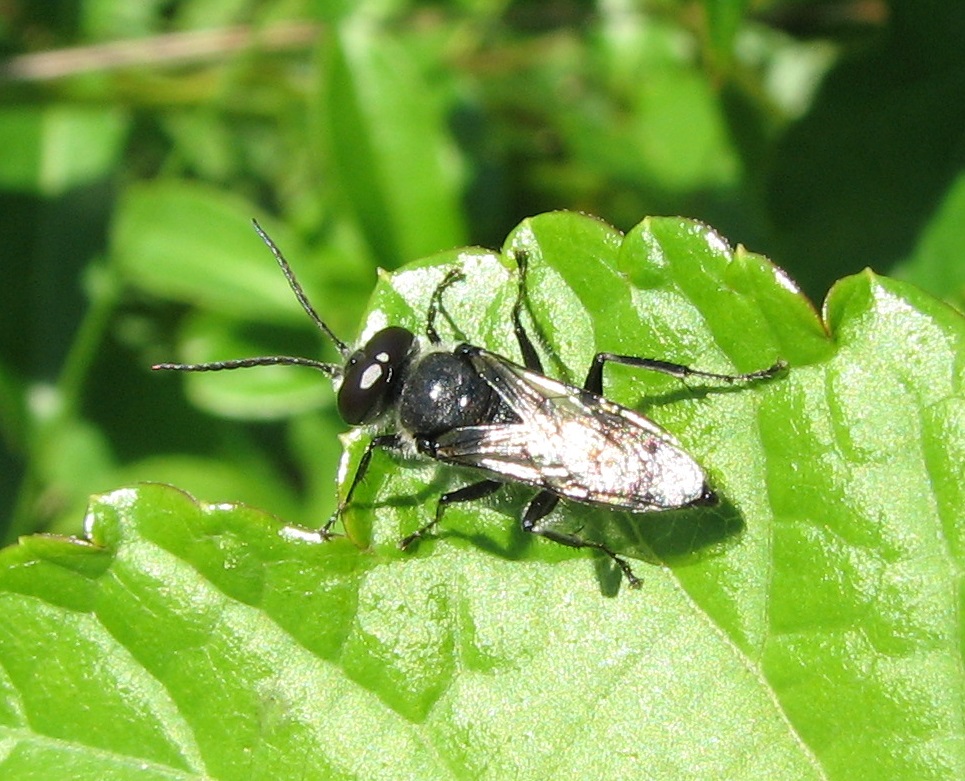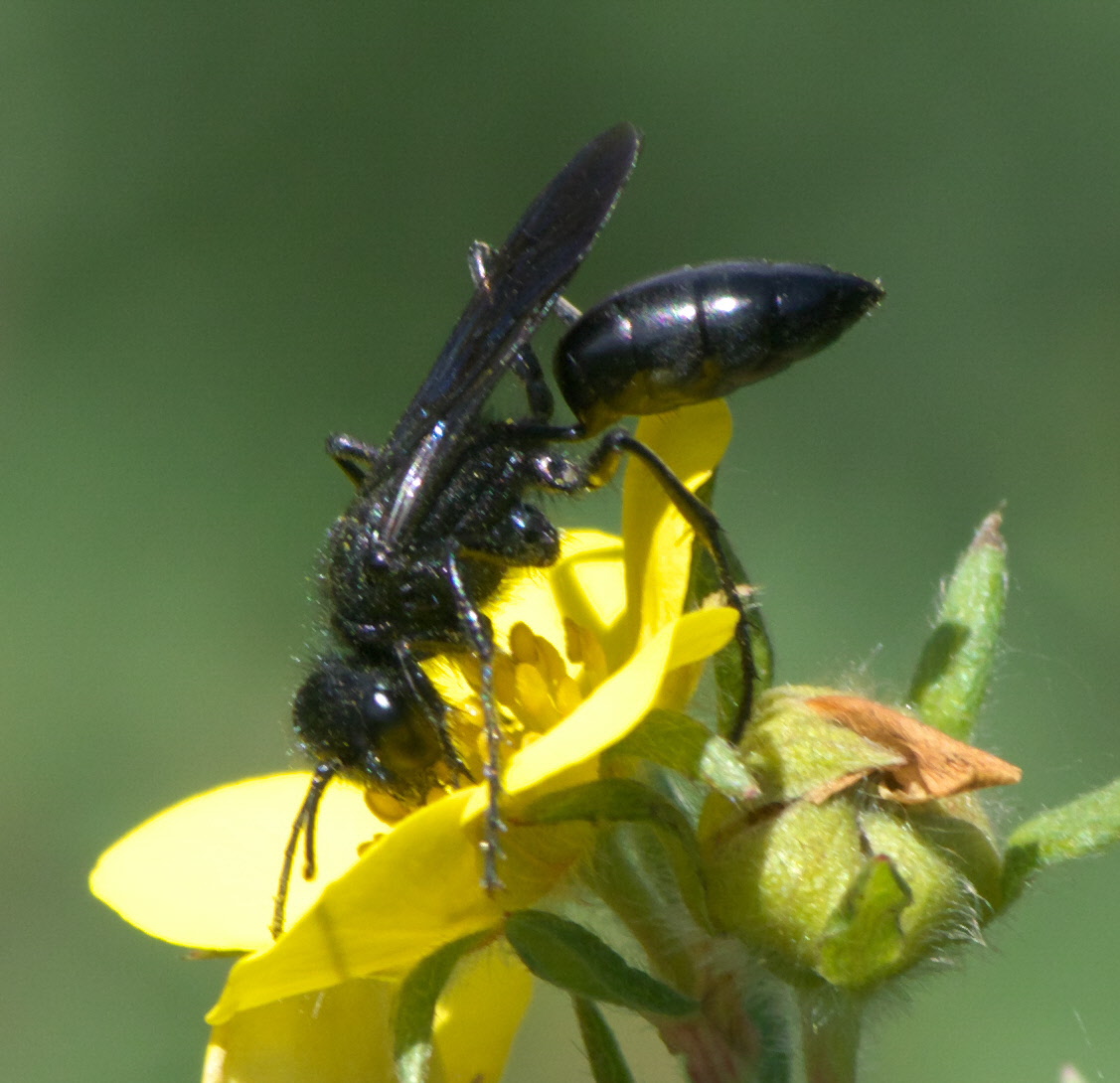|
Sphecoidea
The Spheciformes is a paraphyletic assemblage of insect families which collectively comprise the "sphecoid wasps". Larvae are carnivorous. These are all the members of the superfamily Apoidea, which are not bees and which in older classifications were called the "Sphecoidea". Some are also described as mud dauber Mud dauber (or "mud wasp" or "dirt dauber") is a name commonly applied to a number of wasps from either the family Sphecidae or Crabronidae which build their nests from mud; this excludes members of the family Vespidae (especially the subfamily Eu ...s. The group is paraphyletic because the bees are believed to have arisen from a subgroup within the family Ammoplanidae, thus Spheciformes does not include all of the descendants of its common ancestor.Manuela Sann, Oliver Niehuis, Ralph S. Peters, Christoph Mayer, Alexey Kozlov, Lars Podsiadlowski, Sarah Bank, Karen Meusemann, Bernhard Misof, Christoph Bleidorn and Michael Ohl (2018) Phylogenomic analysis of Apoidea sh ... [...More Info...] [...Related Items...] OR: [Wikipedia] [Google] [Baidu] |
Apoidea
The superfamily (zoology), superfamily Apoidea is a major group within the Hymenoptera, which includes two traditionally recognized lineages, the "sphecidae, sphecoid" wasps, and the bees. Molecular phylogeny demonstrates that the bees arose from within the traditional "Crabronidae", so that grouping is paraphyletic, and this has led to a reclassification to produce monophyletic families.Manuela Sann, Oliver Niehuis, Ralph S. Peters, Christoph Mayer, Alexey Kozlov, Lars Podsiadlowski, Sarah Bank, Karen Meusemann, Bernhard Misof, Christoph Bleidorn and Michael Ohl (2018) Phylogenomic analysis of Apoidea sheds new light on the sister group of bees. ''BMC Evolutionary Biology'' 18:71. doi:10.1186/s12862-018-1155-8 Nomenclature Bees appear in recent classifications to be a specialized lineage of "Crabronidae, crabronid" wasps that switched to the use of pollen and nectar as larval food, rather than insect prey; this makes the traditional "Crabronidae" a paraphyletic group. Accordingl ... [...More Info...] [...Related Items...] OR: [Wikipedia] [Google] [Baidu] |
Crabronidae
The Crabronidae are a large paraphyletic group (nominally a family) of wasps, including nearly all of the species formerly comprising the now-defunct superfamily Sphecoidea. It collectively includes well over 200 genera, containing well over 9000 species. Crabronids were originally a part of Sphecidae, but the latter name is now restricted to a separate family based on what was once the subfamily Sphecinae. Several of the subfamilies of Crabronidae are often treated as families in their own right, as is true of the most recent phylogenies (example below). Phylogeny This phylogenetic tree is based on Sann ''et al.'', 2018, which used phylogenomics to demonstrate that both the bees (Anthophila) and the Sphecidae arose from within the former Crabronidae, which is therefore paraphyletic, and which they suggested should be split into several families; the former family Heterogynaidae nests within the Bembicidae, as here defined. These findings differ in several details from studie ... [...More Info...] [...Related Items...] OR: [Wikipedia] [Google] [Baidu] |
Spheciformes
The Spheciformes is a paraphyletic assemblage of insect family (biology), families which collectively comprise the "sphecoid wasps". Larvae are carnivorous. These are all the members of the superfamily Apoidea, which are not bees and which in older classifications were called the "Sphecoidea". Some are also described as mud daubers. The group is paraphyletic because the bees are believed to have arisen from a subgroup within the family Ammoplanina, Ammoplanidae, thus Spheciformes does not include all of the descendants of its common ancestor.Manuela Sann, Oliver Niehuis, Ralph S. Peters, Christoph Mayer, Alexey Kozlov, Lars Podsiadlowski, Sarah Bank, Karen Meusemann, Bernhard Misof, Christoph Bleidorn and Michael Ohl (2018) Phylogenomic analysis of Apoidea sheds new light on the sister group of bees. ''BMC Evolutionary Biology'' 18:71. doi:10.1186/s12862-018-1155-8 References Spheciformes, Apoidea Paraphyletic groups {{Apoidea-stub ... [...More Info...] [...Related Items...] OR: [Wikipedia] [Google] [Baidu] |
Ampulex Compressa
The emerald cockroach wasp or jewel wasp (''Ampulex compressa'') is a solitary wasp of the family Ampulicidae. It is known for its unusual reproductive behavior, which involves stinging a cockroach and using it as a host for its larvae. It thus belongs to the entomophagous parasites. Distribution The wasp is mostly found in the tropical regions of Africa, South Asia, Southeast Asia, and the Pacific islands. The flying wasps are more abundant in the warm seasons of the year. ''A. compressa'' was introduced to Hawaii by F.X. Williams in 1941 as a method of biocontrol. This has been unsuccessful because of the territorial tendencies of the wasp, and the small scale on which they hunt. The species is also found in the Brazilian states of São Paulo and Rio de Janeiro. ''A. compressa'' likely arrived in the country through the ports of Santos and Rio de Janeiro. Description The wasp has a metallic blue-green body, with the thighs of the second and third pair of legs red. The fe ... [...More Info...] [...Related Items...] OR: [Wikipedia] [Google] [Baidu] |
Ampulicidae
The Ampulicidae, or cockroach wasps, are a small (about 170 species), primarily tropical family of sphecoid wasps, all of which use various cockroaches as prey for their larvae. They tend to have elongated jaws, pronounced neck-like constrictions behind the head, strongly petiolate abdomens, and deep grooves on the thorax. Many are quite ant-like in appearance, though some are brilliant metallic blue, green, and hot pink. Most species sting the roach more than once and in a specific way. The first sting is directed at nerve ganglia in the cockroach's thorax, temporarily paralyzing the victim for a few minutes - more than enough time for the wasp to deliver a second sting. The second sting is directed into a region of the cockroach's brain that controls the escape reflex, among other things. Piper, Ross (2007), ''Extraordinary Animals: An Encyclopedia of Curious and Unusual Animals'', Greenwood Press. When the cockroach has recovered from the first sting, it makes no attempt to f ... [...More Info...] [...Related Items...] OR: [Wikipedia] [Google] [Baidu] |
Sphecidae
The Sphecidae are a cosmopolitan family of wasps of the suborder Apocrita that includes sand wasps, mud daubers, and other thread-waisted wasps. The name Sphecidae was formerly given to a much larger grouping of wasps. This was found to be paraphyletic, so most of the old subfamilies have been moved to the Crabronidae. Biology The biology of the Sphecidae, even under the restricted definition, is still fairly diverse; some sceliphrines even display rudimentary forms of sociality, and some sphecines rear multiple larvae in a single large brood cell. Many nest in pre-existing cavities, or dig simple burrows in the soil, but some species construct free-standing nests of mud and even (in one genus) resin. All are predatory and parasitoidal, but the type of prey ranges from spiders to various dictyopterans, orthopteroids and larvae of either Lepidoptera or other Hymenoptera; the vast majority practice mass provisioning, providing all the prey items prior to laying the egg. Phylo ... [...More Info...] [...Related Items...] OR: [Wikipedia] [Google] [Baidu] |
Paraphyletic
In taxonomy (general), taxonomy, a group is paraphyletic if it consists of the group's most recent common ancestor, last common ancestor and most of its descendants, excluding a few Monophyly, monophyletic subgroups. The group is said to be paraphyletic ''with respect to'' the excluded subgroups. In contrast, a monophyletic group (a clade) includes a common ancestor and ''all'' of its descendants. The terms are commonly used in phylogenetics (a subfield of biology) and in the tree model of historical linguistics. Paraphyletic groups are identified by a combination of Synapomorphy and apomorphy, synapomorphies and symplesiomorphy, symplesiomorphies. If many subgroups are missing from the named group, it is said to be polyparaphyletic. The term was coined by Willi Hennig to apply to well-known taxa like Reptilia (reptiles) which, as commonly named and traditionally defined, is paraphyletic with respect to mammals and birds. Reptilia contains the last common ancestor of reptiles a ... [...More Info...] [...Related Items...] OR: [Wikipedia] [Google] [Baidu] |
Insect
Insects (from Latin ') are pancrustacean hexapod invertebrates of the class Insecta. They are the largest group within the arthropod phylum. Insects have a chitinous exoskeleton, a three-part body ( head, thorax and abdomen), three pairs of jointed legs, compound eyes and one pair of antennae. Their blood is not totally contained in vessels; some circulates in an open cavity known as the haemocoel. Insects are the most diverse group of animals; they include more than a million described species and represent more than half of all known living organisms. The total number of extant species is estimated at between six and ten million; In: potentially over 90% of the animal life forms on Earth are insects. Insects may be found in nearly all environments, although only a small number of species reside in the oceans, which are dominated by another arthropod group, crustaceans, which recent research has indicated insects are nested within. Nearly all insects hatch from eggs. ... [...More Info...] [...Related Items...] OR: [Wikipedia] [Google] [Baidu] |
Family (biology)
Family ( la, familia, plural ') is one of the eight major hierarchical taxonomic ranks in Linnaean taxonomy. It is classified between order and genus. A family may be divided into subfamilies, which are intermediate ranks between the ranks of family and genus. The official family names are Latin in origin; however, popular names are often used: for example, walnut trees and hickory trees belong to the family Juglandaceae, but that family is commonly referred to as the "walnut family". What belongs to a family—or if a described family should be recognized at all—are proposed and determined by practicing taxonomists. There are no hard rules for describing or recognizing a family, but in plants, they can be characterized on the basis of both vegetative and reproductive features of plant species. Taxonomists often take different positions about descriptions, and there may be no broad consensus across the scientific community for some time. The publishing of new data and opini ... [...More Info...] [...Related Items...] OR: [Wikipedia] [Google] [Baidu] |
Mud Dauber
Mud dauber (or "mud wasp" or "dirt dauber") is a name commonly applied to a number of wasps from either the family Sphecidae or Crabronidae which build their nests from mud; this excludes members of the family Vespidae (especially the subfamily Eumeninae), that are instead referred to as "potter wasps". Mud daubers belong to different families and are variable in appearance. Most are long, slender wasps about in length. The name refers to the nests that are made by the female wasps, which consist of mud molded into place by the wasp's mandibles. Mud daubers are not normally aggressive, but can become belligerent when threatened. Stings are uncommon. Nests The organ pipe mud dauber, one of many mud daubers in the family Crabronidae, builds nests in the shape of a cylindrical tube resembling an organ pipe or pan flute. Common sites include vertical or horizontal faces of walls, cliffs, bridges, overhangs and shelter caves or other structures. The nest of a black and yellow mud ... [...More Info...] [...Related Items...] OR: [Wikipedia] [Google] [Baidu] |
Ammoplanina
Ammoplanina is a subtribe of aphid wasps in the family Crabronidae, subfamily Pemphredoninae. There are about 10 genera and at least 130 described species in Ammoplanina. In some phylogenetic analyses, this group is the sister lineage to the bees, and accorded family rank as Ammoplanidae so as to keep families monophyletic.Manuela Sann, Oliver Niehuis, Ralph S. Peters, Christoph Mayer, Alexey Kozlov, Lars Podsiadlowski, Sarah Bank, Karen Meusemann, Bernhard Misof, Christoph Bleidorn, and Michael Ohl (2018) Phylogenomic analysis of Apoidea sheds new light on the sister group of bees. ''BMC Evolutionary Biology'' 18:71. doi:10.1186/s12862-018-1155-8 Genera These 10 genera belong to the subtribe Ammoplanina: * '' Ammoplanellus'' Gussakovskij, 1931 * '' Ammoplanops'' Gussakovskij, 1931 * ''Ammoplanus'' Giraud, 1869 * '' Ammostigmus'' Antropov, 2010 * '' Mohavena'' Pate, 1939 * '' Parammoplanus'' Pate, 1939 * '' Protostigmus'' Turner, 1918 * ''Pulverro'' Pate, 1937 * '' Riparena'' Pat ... [...More Info...] [...Related Items...] OR: [Wikipedia] [Google] [Baidu] |

.jpg)


